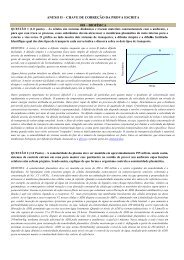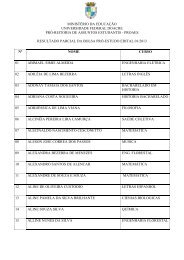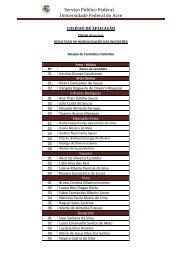Revista Brasileira de Ornitologia - Universidade Federal do Acre
Revista Brasileira de Ornitologia - Universidade Federal do Acre
Revista Brasileira de Ornitologia - Universidade Federal do Acre
You also want an ePaper? Increase the reach of your titles
YUMPU automatically turns print PDFs into web optimized ePapers that Google loves.
450Records of the Crowned Eagle (Urubitinga coronata) in Moxos plains of Bolivia and observations about breeding behaviorIgor Berkunsky, Gonzalo Daniele, Fe<strong>de</strong>rico P. Kacoliris, Sarah I. K. Faegre, Facun<strong>do</strong> A. Gan<strong>do</strong>y, Lyliam González & José A. Díaz Luque1 December 2007) and two six-ban<strong>de</strong>d armadillos(Euphractus sexcinctus one individual on 23 November2007 and another individual on 7 January 2008). Reportedprey of Crowned Eagles in other countries inclu<strong>de</strong>terrestrial vertebrates such as armadillos (Dasypodidae),skunks (Mustelidae), opposums (Di<strong>de</strong>lphidae), tinamous(Tinamidae), <strong>do</strong>mestic chickens (Gallus <strong>do</strong>mesticus),some reptiles, <strong>de</strong>ad animals and fishes (Collar et al.1992, Bellocq et al. 2002, Maceda et al. 2003, Maceda2007, Tittarelli & Villarreal 2009, Pereyra Lobos et al.2011). As in other countries, armadillos seem to havean important role in the eagle’s diet during the breedingseason (Maceda et al. 2003, Pereyra Lobos et al. 2011).Armadillos and other terrestrial animals are usuallyaffected by fire, an annual human activity in Moxos plains(Langstroth Plotkin 1996). These fires could be affectingthe availability of prey for Crowned Eagles.New localities reported in this work suggest thatMoxos plains are a favorable environment for the speciesand its presence could be better known. The plains ofMoxos is an important site for the species. We observed atleast seven individuals, including family groups, juvenilesand a nestling, confirming the reproduction of CrownedEagles in Moxos plains. Botflies and fire may act aspotential threats for this northwestern-most populationof the endangered Crowned Eagle.ACKNOWLEDGMENTSMost of these observations were possible thanks tothe Blue-throated Macaw Conservation Project (WorldParrot Trust). We thank Wilfre<strong>do</strong> Villavicencio, RobertoFernan<strong>de</strong>z (Don Bobby), Hernán Parada and Fernan<strong>do</strong>Ávila for allowing us to work on their properties. SergioSeipke provi<strong>de</strong>s valuable suggestions to improve themanuscript.REFERENCESAraujo, N.; Ibisch, P. & Cuellar, S. 2001. Diagnóstico <strong>de</strong> Biodiversida<strong>de</strong> insumos técnicos para el Plan <strong>de</strong> Manejo <strong>de</strong>l área ProtegidaMunicipal Santiago, Tucavaca. Santa Cruz <strong>de</strong> la Sierra: FundaciónAmigos <strong>de</strong> la Naturaleza, Informe Técnico.Bal<strong>de</strong>rrama, J. A.; Olivo, C.; Flores, B. & Crespo, M. 2009.Harpyhaliaetus coronatus, p. 337-338. In: Ministerio <strong>de</strong> MedioAmbiente y Agua (eds). Libro rojo <strong>de</strong> la fauna silvestre <strong>de</strong>vertebra<strong>do</strong>s <strong>de</strong> Bolivia. La Paz: Ministerio <strong>de</strong> Medio Ambientey Agua.Barcellos, A. & Accordi, I. A. 2006. New records of the CrownedEagle, Harpyhaliaetus coronatus, in the State of Rio Gran<strong>de</strong> <strong>do</strong> Sul,southern Brazil. <strong>Revista</strong> <strong>Brasileira</strong> <strong>Ornitologia</strong>, 14: 345-349.Bellocq, M. I.; Bonaventura, S. M.; Marcelino, F. N. & Sabatini,M. 1998. Habitat use of Crowned Eagles (Harpyhaliaetuscoronatus) in the southern limits of the species’ range. Journal ofRaptor Research, 32: 312-314.Bellocq, M. I.; Ramírez-Llorens, P. & Filloy, J. 2002. Recent recordsof Crowned Eagles (Harpyhaliaetus coronatus) from Argentina.1981-2000. Journal of Raptor Research, 36: 206-212.Birdlife International. 2012. Species factsheet: Harpyhaliaetuscoronatus. http://www.birdlife.org (access on 24 January 2012).Brace, R. C.; Hornbuckle, J. & Pearce-Higgins, J. W. 1997. Theavifauna of the Beni Biological Station, Bolivia. Bird ConservationInternational , 7: 117-159.Collar, N. J.; Gonzaga, L. P.; Krabbe, N.; Madroño Nieto, A.;Naranjo, L. G.; Parker III, T. A. & Wege, D. C. 1992. Threatenedbirds of the Americas: the ICBP/IUCN Red Data Book. Cambridge:International Council for Bird Preservation.Denevan, W. 1980. La geografía cultural <strong>de</strong> los aborígenes <strong>de</strong> los Llanos<strong>de</strong> Mojos. La Paz: Sibiria Ed. Juventud.Ferguson-Lees, J. & Christie, D. A. 2001. Raptors of the World. NewYork: Houghton and Mifflin Company.Hennessey, A. B.; Herzog, S. K. & Sagot, F. 2003. Lista anotada <strong>de</strong>las aves <strong>de</strong> Bolivia. Santa Cruz <strong>de</strong> la Sierra: Asociación Armonía/BirdLife International.IUCN. 2012. IUCN Red List of Threatened Species. Version 2012.1.www.iucnredlist.org. (access on 27 August 2012)Kingsbury, J. & McNeill, D. 2010. Bolivia 2010, A joint GlasgowUniversity and Bolivian conservation expedition to the Beni savannahof Bolivia. Glasgow: Glasgow University.Kratter, A. W.; Scotts Illett, J. T.; Terry Chesser, R.; O’Neill, J. P.;Parker, T. A. & Castillo, A. 1993. Avifauna of a Chaco locality inBolivia. Wilson Bulletin, 105: 114-141.Langstroth Plotkin, R. 1996. Forest islands in an amazonian savannaof northeastern Bolivia. Ph.D. dissertation. Madison: University ofWisconsin-Madison.Maceda, J. J. 2007. Biología y conservación <strong>de</strong>l Águila coronada(Harpyhaliaetus coronatus) en Argentina. Hornero, 22: 159-171.Maceda, J. J.; Sarasola, J. H. & María Pessino, M. E. 2003. Preyconsumed by the Crowned Eagle (Harpyhaliaetus coronatus) in thesouthern limits of its range in Argentina. <strong>Ornitologia</strong> Neotropical,14: 419-422.Maillard, O.; Quillén Vi<strong>do</strong>z, J. & Herrera, M. 2008. Registrossignificativos <strong>de</strong> aves para el <strong>de</strong>partamento <strong>de</strong>l Beni, Bolivia: parte2. Kempffiana, 4: 8-12.Monteiro Granzinolli, M. A.; Garcia Pereira, R. J. & Motta-Junior,J. C. 2006. The Crowned Solitary-Eagle Harpyhaliaetus coronatus(Accipitridae) in the cerra<strong>do</strong> of Estação Ecológica <strong>de</strong> Itirapina,southeast Brazil. <strong>Revista</strong> <strong>Brasileira</strong> <strong>Ornitologia</strong>, 14: 429-432.Pereyra Lobos, R.; Santan<strong>de</strong>r, F. J.; Alvara<strong>do</strong> Orellana, S.; Ramírez,P. A.; Muñoz, L. & Fernán<strong>de</strong>z Bellón, D. 2011. Diet of theCrowned Eagle (Harpyhaliaetus coronatus) during the breedingseason in the Monte Desert, Men<strong>do</strong>za, Argentina. Journal ofRaptor Research, 45: 180-183.Quiroga, O. A. & Malo, A. F. 2006. Composición <strong>de</strong> la avifauna <strong>de</strong>lárea protegida Pantanal <strong>de</strong> Otuquis (Santa Cruz, Bolivia). <strong>Revista</strong>Boliviana <strong>de</strong> Ecología y Conservación Ambiental, 19: 59-73.Rocha, O. 1990. Lista preliminar <strong>de</strong> aves <strong>de</strong> la Reserva <strong>de</strong> la Biosfera“Estación Biológica Beni”. Ecología en Bolivia, 15: 57-68.Sarasola, J. H. & Maceda, J. J. 2006. Past and current evi<strong>de</strong>nceof persecution of the Endangered crowned eagle Harpyhaliaetuscoronatus in Argentina. Oryx, 40: 347-350.Thiollay, J. M. 1994. Family Accipitridae, p. 52-205. In: J. <strong>de</strong>l Hoyo,J. Elliot. & J. Sargatal (eds.). Handbook of the birds of the world,New World vultures to guineafowl, v. 2. Barcelona: Lynx Edicions.Tittarelli, R. F. & Villarreal, D. 2009. Alimentación piscívora <strong>de</strong>un pichón <strong>de</strong> águila coronada (Harpyhaliaetus coronatus) en losbaña<strong>do</strong>s <strong>de</strong>l Atuel, La Pampa, Argentina. Nuestras Aves, 54: 41-42.Vi<strong>do</strong>z, J. Q.; Jahn, A. E. & Mamani, A. M. 2010a. The avifauna ofEstación Biológica Caparú, Bolivia. Cotinga, 32: 51-68.Vi<strong>do</strong>z, J. Q.; Aponte, M. A.; Velásquez, M. A. & Alarcón, R.2010b. Contribución al conocimiento <strong>de</strong> la avifauna <strong>de</strong>l ParqueNacional Kaa-Iya <strong>de</strong>l Gran Chaco, <strong>de</strong>partamento <strong>de</strong> Santa Cruz,Bolivia. <strong>Revista</strong> <strong>Brasileira</strong> <strong>Ornitologia</strong>, 18: 34-44.<strong>Revista</strong> <strong>Brasileira</strong> <strong>de</strong> <strong>Ornitologia</strong>, 20(4), 2012










